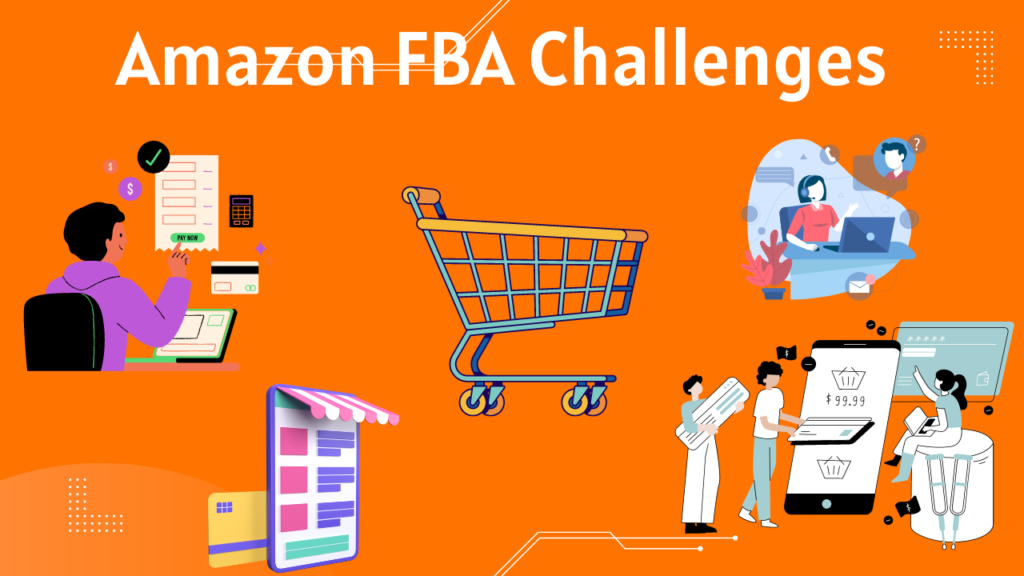
If you’re an online seller, you’re probably familiar with Amazon FBA (Fulfillment by Amazon), which has become an increasingly popular way to grow your business. However, with the many benefits come a few challenges that you should be aware of. In this article, we’ll take a closer look at the top challenges associated with Amazon FBA, explore some possible solutions, and give you tips on how to overcome them.
Top 10 Amazon FBA Challenges Faced by Sellers
Overcoming the Complexity of Amazon FBA

Amazon FBA requires a certain level of flexibility and adaptability, especially when handling the various processes involved. The complexity of FBA can be intimidating, especially for new sellers seeking to make the most of the service. One way to tackle this challenge is to take time to familiarize yourself with the Amazon FBA program and its user interface. Education and acquiring the right skills necessary to navigate through the program can help make your FBA experience much smoother and more efficient.
Another way to overcome the complexity of Amazon FBA is to stay organized. As a seller, you’ll be managing multiple products, shipments, and orders. It’s important to keep track of everything to avoid confusion and potential errors. Use tools such as spreadsheets or specialized software to help you organize your inventory, shipments, and orders. This will help you stay on top of everything and ensure that your customers receive their orders on time.
One common challenge that FBA sellers face is managing their inventory. Amazon FBA allows you to store your products in their fulfillment centers, but it’s important to keep track of your inventory levels. Make sure to regularly check your inventory levels and restock when necessary. You don’t want to run out of stock and miss out on potential sales. Additionally, it’s important to manage your inventory to avoid long-term storage fees. Amazon charges fees for products that have been in their fulfillment centers for more than 365 days. Make sure to keep track of your inventory and remove any products that are not selling well to avoid these fees.
Customer service is also an important aspect of selling on Amazon FBA. As a seller, you’re responsible for providing excellent customer service to your buyers. This includes responding to customer inquiries in a timely manner, resolving any issues or complaints, and providing accurate tracking information. Make sure to keep your customers informed throughout the entire process, from order confirmation to delivery. This will help build trust and loyalty with your customers, leading to positive reviews and increased sales.
Finally, staying up-to-date with Amazon’s policies and guidelines is important. Amazon frequently updates its policies, so it’s important to regularly check for any changes that may affect your business. Make sure to follow Amazon’s policies and guidelines to avoid any potential penalties or suspension of your account. You can also join Amazon seller forums or groups to stay informed and connect with other sellers.
By staying organized, providing excellent customer service, and staying up-to-date with Amazon’s policies, you can overcome the complexity of Amazon FBA and achieve success as a seller on the platform.
Amazon FBA Storage Limitations

Storage limitations can be a significant hindrance to sellers on Amazon FBA, particularly those who deal with high levels of inventory. Amazon has strict storage limits in place, and exceeding them can result in penalties in the form of costly storage fees.
It’s important to understand that Amazon’s storage limits are in place to ensure that their warehouses are not overcrowded and that products can be shipped quickly and efficiently. This means that as a seller, you need to be strategic in your inventory management process to ensure that you’re not exceeding these limits.
One way to optimize your inventory management process is by using Amazon’s Inventory Performance Index (IPI). This tool provides sellers with a score that reflects their inventory management performance, and it’s essential to maintain a score of at least 350 to avoid storage fees.
Another way to avoid exceeding Amazon’s storage limits is by selling hot products that move fast. This means that you need to stay on top of industry trends and make sure that you’re offering products that are in high demand. It’s also a good idea to consider seasonal trends and adjust your inventory accordingly.
In addition to optimizing your inventory management process and selling hot products, you can also consider using multi-channel FBA integration. This means that you can fulfill orders from other marketplaces or your own website using Amazon’s FBA service. This can help you diversify your sales channels and reduce the risk of exceeding Amazon’s storage limits.
It’s important to note that Amazon’s storage guidelines vary depending on the time of year and the category of the product. It’s essential to stay up to date with these guidelines to avoid any penalties or fees.
In conclusion, while Amazon’s storage limitations can be a challenge for sellers, there are ways to optimize your inventory management process and avoid costly penalties. By using tools like Amazon’s IPI, selling hot products, and considering multi-channel FBA integration, you can stay within Amazon’s storage guidelines and continue to grow your business on the platform.
Amazon FBA Aged Inventory Surcharges

Product inventory that has been sitting in Amazon warehouses for long periods is subject to additional fees in the form of surcharges. This particular challenge can impact the overall profitability of your business significantly. The best way to avoid aged inventory is to conduct regular product analysis and adjust your inventory strategy accordingly.
It’s important to note that the definition of “long periods” can vary depending on the product and category. For example, if you sell seasonal items like Christmas decorations, it’s expected that your inventory will sit in the warehouse for several months before it sells. On the other hand, if you sell electronics, you may want to be more cautious about keeping inventory in the warehouse for too long.
One way to avoid aged inventory surcharges is to set up automatic removals for products that haven’t sold within a certain timeframe. This can help to keep your inventory fresh and prevent you from getting hit with unexpected fees. Another option is to offer promotions or discounts to encourage customers to purchase items that have been sitting in the warehouse for too long.
It’s also worth noting that aged inventory can be a sign of larger issues with your business, such as poor sales or ineffective marketing. By regularly analyzing your inventory and sales data, you can identify these issues and take steps to address them before they become a bigger problem.
In conclusion, while aged inventory surcharges can be frustrating and costly, there are steps you can take to avoid them. By staying on top of your inventory and regularly analyzing your sales data, you can ensure that your business is running smoothly and efficiently.
Amazon FBA SKU Labeling

Amazon is one of the world’s largest online marketplaces, with millions of sellers worldwide. To ensure that the products sold on its platform meet certain standards, Amazon has strict labeling guidelines that sellers must follow. These guidelines apply to all products, regardless of their category, size, or weight.
The labeling process can be challenging, especially if you have a large inventory. One of the most critical aspects of labeling is ensuring that each item has a unique identifier, known as a SKU (Stock Keeping Unit). The SKU is a unique code that helps Amazon identify each item and track its movement within its fulfillment centers.
To avoid the potential chaos that incorrect labeling can cause, it’s essential to follow best practices. One of the best ways to do this is by investing in labeling software. Labeling software can help you create and print labels quickly and accurately, reducing the risk of errors and saving you time.
Another best practice is to document standard operating procedures (SOPs) for your labeling process. SOPs are step-by-step instructions that outline how to perform a particular task. By documenting your labeling procedures, you can ensure that everyone involved in the process follows the same steps, reducing the risk of errors and inconsistencies.
Finally, you can leverage automated services like those offered by Amazon’s labeling partner companies. These companies offer a range of services, including label printing, label application, and even barcode scanning. By using these services, you can streamline your labeling process and reduce the risk of errors.
In conclusion, Amazon FBA SKU labeling is an essential aspect of selling on Amazon. By following best practices, such as investing in labeling software, documenting SOPs, and leveraging automated services, you can ensure that your products meet Amazon’s labeling guidelines, reducing the risk of errors and improving your overall selling experience.
Delayed Profitability
When establishing your business on Amazon, it takes time to start seeing profitable returns. It’s essential to remain patient and avoid the temptation to give up. One way to speed up the process is to optimize your product listings and pricing. Conducting regular reviews and monitoring factors like competition, customer demand, and sales performance can help you understand what your customers want and tailor your listings accordingly.
Competition Overload
Competition on Amazon is intense, and sellers need to be proactive if they want to stay ahead of the pack. Observing industry trends, doing competitor analysis, and improving your product differentiation can give you an edge. Additionally, consider establishing partnerships with other sellers and leveraging marketing tools to drive traffic to your listings.
Amazon Price Wars
The Amazon marketplace can be subject to price wars between sellers looking to offer the lowest prices possible to lure in more customers. While this can be good for the customer, it can be detrimental for the sellers. One solution is to offer differentiated products, finding new ways to promote your products, and using promotions strategically to encourage customer loyalty.
Receiving Amazon Feedback
Amazon feedback is necessary to keep your business running, but it can also be a double-edged sword. Negative feedback can hurt your business and reputation, while positive feedback can help improve customer trust in your brand. Incorporating a proactive customer service strategy, ensuring fast order fulfillment, and addressing negative feedback from customers can help to maintain a good reputation.
Packaging Restrictions
Amazon sellers must adhere to strict packaging guidelines when sending inventory to Amazon warehouses. Failure to comply can result in additional fees, wasted resources, and lost sales. Finding a packaging specialist or leveraging tool kits such as Amazon’s Certified Packaging Program can help you understand Amazon’s packaging requirements. Furthermore, considering the impacts of sustainability and eco-friendly packaging can be beneficial, particularly for niche markets.
High Amazon Fees – How To Solve Challenges
Amazon FBA fees are typically higher than those of other eCommerce fulfillment service providers. Even so, the program’s benefits are worth the investment. Conducting a comprehensive cost-benefit analysis and incorporating tools like FBA fee calculators into your financial analysis can help you make informed decisions. Additionally, try to minimize returns, balance your inventory levels efficiently, and use FBA services as effectively as possible to maximize your return on investment (ROI).
Conclusion
Amazon FBA poses several challenges, but like most things in life, preparation and a willingness to adapt and learn can go a long way. With the right mindset, strategy, and execution, you can overcome even the most significant challenges associated with Amazon FBA and grow your business to new heights.
